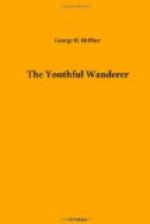The view from the top of the tower takes in the greater part of Holland. The country all around is quite level, as far as the eye can see. Level, in Holland, means level. Here one sees the innumerable wind-mills, and the labyrinthic net-work of canals which intersect Holland. An almost boundless expanse of meadow land stretches out in every direction, and affords excellent pasture to the lowing herds that roam upon it. One sees but a few scattered trees, and several small woods, all the rest is clear and bear—no hedge-fences even to interrupt the dull monotony of the scene below. A strong wind, and it was high too, whistled around that lofty tower, reminding me of our winter storms when they whistle over the chimney-tops—a music that often makes melancholy hearts home-sick.
It was exactly 12:00 o’clock, and I was in the middle of the sentence, “How beautiful these bells chime,” when a boy motioned me to come quickly to a certain place where I could see the cylinder revolve which communicates with the peal of bells.
Two points of lightning-rods crown this tower. Few lightning-rods are to be seen upon private buildings, in Europe, but upon public buildings they are occasionally met with.
I must not leave Holland without once more referring to the rattling of the wooden shoes upon the pavements, the red artificial flowers which old gray-headed women wear upon their heads and the gaudy colors of some of their dresses; also to the universal custom of carrying everything upon their heads.
The denominations of Dutch money are florins or guldins, and cents; 100 cents equal one florin. The florin is equal to 40 cents in United States money.
At 12:38 p.m., I left by train for Cologne, Germany. By 1:00 o’clock we entered a desolate section of country consisting of barren sandy soil, scanty crops, and dwarfish shrubs and trees. On our way, I formed the acquaintance of an elderly gentleman who moved from Holland to this country nineteen years ago. This gentleman explained to me the agricultural institutions of Holland. He now lives in new Holland, Ottowa Co., Michigan, a town of 3,000 inhabitants, most of which are natives of Holland. There are about 15,000 more of his native countrymen living in the neighborhood of new Holland and at Grand Rapids. They have a newspaper published in their language in this country. At 2:25 we reached Arnheim where my Dutch friend left me.
At Zeevenaar (near the boundary between Holland and Germany) we passed muster. Soon after we crossed the Rhine on a ferry, which carried us and the whole trains of cars over together. Thence we rode through Rhenish Prussia on, on, until we reached Cologne.
Chapter XII.
Cologne.
Koeln, (or Cologne), the principal town in the Rhenish Province of Prussia, the seat of the supreme court of justice for the west bank of the Rhine, one of the chief commercial cities in Germany, and a military stronghold of the first class, is an old Catholic city dating its foundation from the 1st century of the Christian era. In the beginning of the present century, it had 200 churches and chapels; it has at present 25 only, two of which are prodestant.




